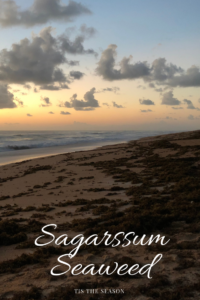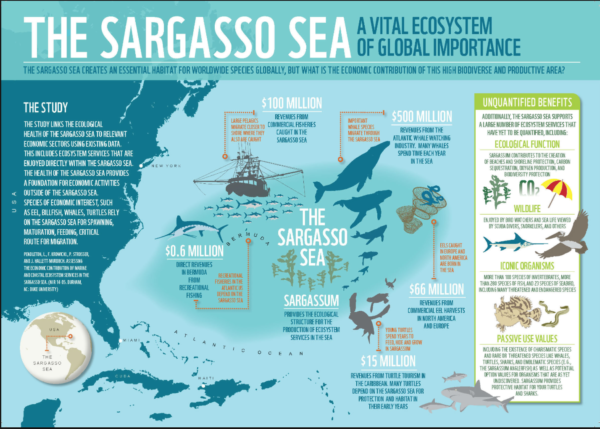
A lot of folks come here with notions of blue-green water and a sandy beach to walk along. For those who’ve lived here and have been part of the tide’s rise and fall, we know that while this is true much of the time it’s not necessarily a constant. So here are some little known facts and observances about the seaweed which washes up periodically along our beach. Although it seems to be a nuisance, let me assure you it is NOT and after reading this little blurb hopefully, you will have a new found appreciation for its arrival.
The sargassum seaweed washes up periodically throughout the year. According to my own life’s observations this occurs after and during (if a long enough duration) most Nor’easter wind events. The reason this takes place during Nor’easters is due to the fact that there is a direct line of open ocean to the Sargasso Sea, which is located to our NE. This is the only sea in the world which is bordered entirely by water, due to several bordering currents.
Sargassum is home to many different species of sea life. Henceforth, it is a prime source of nutrition for the beloved sea turtles of this region as well as many other critters of the ocean. Not only a source of food for grazing turtles, the seaweed patches are perfect little camouflaged shelters strewn along the sand. These patches on the beach aid newly hatched turtles in hiding from predators (i.e. birds) namely seagulls, when making their run to the water’s edge. From there the floating patches (both small and large) serve as hiding spots and grazing stops for the little babies along their near 20 mile trek to the breeding grounds.
To tie these elements of nature together, one must take notice the cycle of events through careful observation of the sea and lunar events. For example, high tide on a full moon hatching event means the turtles have a very short distance to sprint to the water’s edge. In conjunction with hatching on a full moon, our seaweed improves our precious turtles’ chances greatly, which likely makes up for the hatching periods that involve few to none even getting the chance of making their journey. The survival rate for baby turtles according to a book published several years back was, believe it or not, 1 out of 100 hatchlings would ever actually make it to their breeding/grazing grounds and live a full life. Although it may sound like a low number, keep in mind how long turtles can live. Google it!
This is just one of many reasons we love to see sargassum along the shoreline, and although at first glance it may seem like an inconvenience or nuisance or as I’ve heard it called “a stinky mess,” rest assured mother nature has special plans and uses for all her resources. Next time, I will discuss the little known fact that sargassum seaweed helps build and hold the sandy beaches we all enjoy.
Written with love for these beaches by Michael Ceribelli
Michael was born and raised in Florida and has spent his life surfing, swimming, sailing and working on the beach. He also enjoys the inland life on dirt bikes, ATV’s and boating and tubing our many chain lakes and springs. He believes strongly in preserving the ways of Florida life.
Michael is the owner of Frankie Alice’s Beachside Boutique in Flagler Beach and looks forward to meeting new friends everyday!


